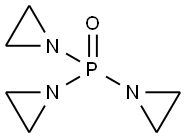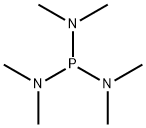TEPA
Synonym(s):KIAA1655;TEF;Thyrotroph embryonic factor
- CAS NO.:545-55-1
- Empirical Formula: C6H12N3OP
- Molecular Weight: 173.16
- MDL number: MFCD00081201
- EINECS: 208-892-5
- SAFETY DATA SHEET (SDS)
- Update Date: 2024-12-18 14:08:57

What is TEPA?
Chemical properties
Colorless crystals. Soluble in water, alcohol, and ether. Combustible.
The Uses of TEPA
Used as insect chemosterilant; in dyeing. Antineoplastic.
The Uses of TEPA
Insect chemosterilant; in dyeing, creaseproofing and flameproofing textiles; stabilizer for polymers; in photographic emulsion hardening.
What are the applications of Application
Triethylenephosphoramide is a chemical used as insect chemosterilant
Definition
ChEBI: Tris(1-aziridinyl)phosphine oxide is a phosphoramide.
General Description
An aqueous solution of a colorless crystalline solid. Toxic by skin absorption, ingestion or inhalation. Produces toxic oxides of nitrogen during combustion. Used as a pesticide.
Reactivity Profile
TRIS-(1-AZIRIDINYL) PHOSPHINE OXIDE may react with aqueous solutions of acids or strong bases. Undergoes slow decomposition in water, not considered hazardous. Polymerizes violently at about 255°F. Acid fumes also cause polymerization at ordinary temperatures [USCG, 1999]. May produce highly toxic and flammable phosphine gas in the presence of strong reducing agents such as hydrides. Partial oxidation by oxidizing agents may result in the release of toxic phosphorus oxides.
Health Hazard
Inhalation (unlikely unless a heavy mist is formed) causes symptoms similar to those observed after ingestion. Contact with liquid or powder causes irritation of eyes and (on prolonged contact) irritation and burns of skin. Burns are slow to develop and slow to heal. May sensitize on repeated contact. Ingestion causes depression, anorexia, and diarrhea, appearing 2-3 days before death, followed by terminal dyspnea, incoordination, epistaxis, salivation, prostration and cyanosis.
Fire Hazard
Special Hazards of Combustion Products: Phosphoric acid mist may form in fire. Toxic oxides of nitrogen may form.
Safety Profile
Poison by ingestion, skin contact, intravenous, and intraperitoneal routes. Experimental teratogenic and reproductive effects. Questionable carcinogen with experimental carcinogenic and neoplastigenic data. Human mutation data reported. A corrosive irritant to the skin, eyes, and mucous membranes. When heated to decomposition it emits very toxic fumes of POx and NOx. Used as an acaricide and in the permanentpress treatment of cotton.
Properties of TEPA
| Melting point: | 41℃ |
| Boiling point: | 299℃ |
| Density | 1.47 |
| Flash point: | 135℃ |
| storage temp. | -20°C |
| solubility | Chloroform (Sparingly), Methanol (Slightly) |
| form | solid |
| pka | 2.74±0.20(Predicted) |
| Stability: | Stable. |
| IARC | 3 (Vol. 9, Sup 7) 1987 |
| EPA Substance Registry System | Aziridine, 1,1',1''-phosphinylidynetris- (545-55-1) |
Safety information for TEPA
Computed Descriptors for TEPA
New Products
(S)-3-Aminobutanenitrile hydrochloride 4-Methylphenylacetic acid N-Boc-D-alaninol N-BOC-D/L-ALANINOL Tert-butyl bis(2-chloroethyl)carbamate 3-Morpholino-1-(4-nitrophenyl)-5,6-dihydropyridin- 2(1H)-one Furan-2,5-Dicarboxylic Acid Tropic acid 1-Bromo-3,5-Di-Tert-Butylbenzene S-2-CHLORO PROPIONIC ACID ETHYL ISOCYANOACETATE 2-Bromo-1,3-Bis(Dimethylamino)Trimethinium Hexafluorophosphate 4-IODO BENZOIC ACID 3-NITRO-2-METHYL ANILINE 1-(2,4-DICHLOROPHENYL) ETHANAMINE (2-Hydroxyphenyl)acetonitrile 4-Bromopyrazole 2-(Cyanocyclohexyl)acetic acid 4-methoxy-3,5-dinitropyridine 1-(4-(aminomethyl)benzyl)urea hydrochloride 2-aminopropyl benzoate hydrochloride diethyl 2-(2-((tertbutoxycarbonyl)amino) ethyl)malonate tert-butyl 4- (ureidomethyl)benzylcarbamate Ethyl-2-chloro((4-methoxyphenyl)hydrazono)acetateRelated products of tetrahydrofuran








You may like
-
 Anti-TEF, C-Terminal antibody produced in rabbit CASView Details
Anti-TEF, C-Terminal antibody produced in rabbit CASView Details -
 2033-24-1 98%View Details
2033-24-1 98%View Details
2033-24-1 -
 1975-50-4 98%View Details
1975-50-4 98%View Details
1975-50-4 -
 2-HYDROXY BENZYL ALCOHOL 98%View Details
2-HYDROXY BENZYL ALCOHOL 98%View Details
90-01-7 -
 2-Chloro-1,3-Bis(Dimethylamino)Trimethinium Hexafluorophosphate 221615-75-4 98%View Details
2-Chloro-1,3-Bis(Dimethylamino)Trimethinium Hexafluorophosphate 221615-75-4 98%View Details
221615-75-4 -
 61397-56-6 CIS BROMO BENZOATE 98%View Details
61397-56-6 CIS BROMO BENZOATE 98%View Details
61397-56-6 -
 14714-50-2 (2-Hydroxyphenyl)acetonitrile 98+View Details
14714-50-2 (2-Hydroxyphenyl)acetonitrile 98+View Details
14714-50-2 -
 118753-70-1 98+View Details
118753-70-1 98+View Details
118753-70-1